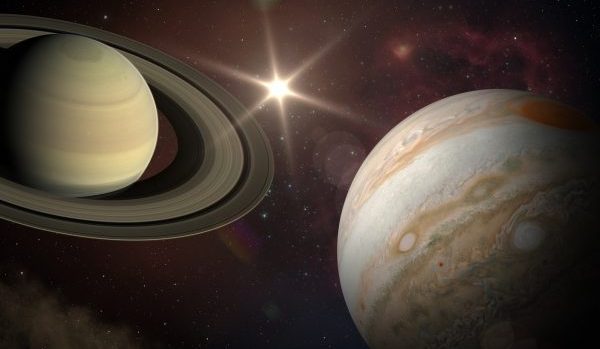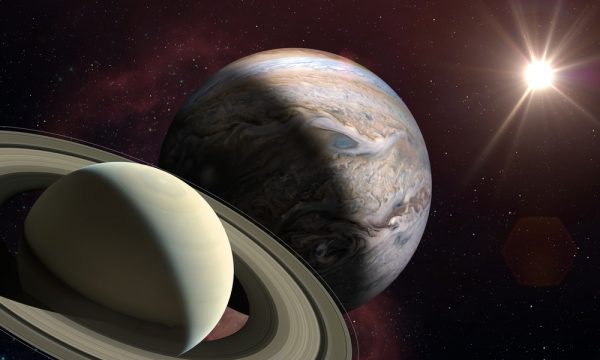Here’s how to view the Christmas star — the Great Conjunction of Jupiter & Saturn — from locations around metro Atlanta and other places in Georgia.

UPDATED on 12/22/2020 — If you missed the conjunction at its peak on Dec. 21st, don’t despair!
Astronomers say the pairing of the planets will remain visible through early January.
Although Jupiter and Saturn are now moving slowly apart, you can still see them in the night sky shortly after sunset on clear nights, using the viewing tips below.
Maybe you’ve heard about the astronomical event that scientists are calling the Great Conjunction and some people are calling The Christmas Star. It is supposed to be highly viewable here in Atlanta, as long as the sky is mostly clear.
We set out to learn a little more about this planetary alignment. Why? Because, for the most part, sky-gazing is free or cheap entertainment. So bundle up the kids and take them outdoors to watch this celestial event!
So here’s what you need to know. It’s our science lesson, simplified for everyday folks.
What is the Great Conjunction?
♦ Jupiter and Saturn are the two largest planets in our solar system. Every 20 years or so, they appear to “meet” in the night sky, as they circle through their planetary paths on the sky’s dome.
♦ When planets meet like this, astronomers call it a conjunction. Because of their giant size, it is called a great conjunction when Jupiter and Saturn align.
♦ To the naked eye, the two planets appear as one bright spot. With binoculars or a telescope, you may be able to see a small space between them.
♦ Conjunctions are not considered rare. However, this year, Jupiter and Saturn will be closer together than they have been in 400 years — since 1623! But the 1623 event was not visible, because it happened during daylight hours. The last highly visible conjunction was way back in the year 1226! This is why you’re hearing so much excitement about the 2020 event. Basically, it is a once-in-a-lifetime opportunity.
♦ If you miss this Great Conjunction, you’ll wait till March 15, 2080 to see the planets align this closely again.
♦ From the earth’s vantage point, the two planets will seem to merge into almost a single point of light, on the evening of the winter solstice, December 21, 2020.
♦ For most Great Conjunctions, Jupiter and Saturn are separated by about 1 degree, which is the width of two full moons in the sky. This year, they will be separated by just one-tenth of a degree, which is one-fifth the size of the full moon.
♦ Because of the timing, and because communities need a symbol of hope these days, some people are calling the upcoming conjunction “The Christmas Star.” It’s just a fun nickname, not necessarily an accurate description.
You may also be interested in:
- Day-by-day list of free & cheap holiday events
- Best places to see holiday lights this year
- Holiday markets around metro Atlanta
- The 10 best Christmas tree farms near Atlanta
- Free photos with Santa for pets and people
- Where to get Christmas dinner to go
How to view the Great Conjunction from Atlanta
During the last great conjunction in 2000, Saturn and Jupiter were near the sun in our sky, which made it hard to observe. But this time they’ll be much lower in the horizon, and should be pretty easy to see, as long as the sky is clear.
There are two ways to watch — outdoors on your own, or through a virtual skygazing event, which we’ve listed below.
Things to know:
These viewing tips were adapted from info supplied by NASA.
♦ Jupiter and Saturn will appear brighter than any star, so you can see them even if you’re in a big city like Atlanta.
♦ How can you tell that you’re looking at a planet and not a star? Planets shine steadily. They don’t twinkle like stars.
♦ You won’t need any highly specialized equipment. You could use binoculars or a small telescope, if you have them handy, but the conjunction will be visible to the naked eye.
♦ You won’t even need to drive outside Atlanta to see it, although your view might be more dramatic if you’re in a location with less light pollution.
♦ The alignment will appear pretty low on the horizon — so you will need an unobstructed view, meaning a view that’s clear of trees or tall buildings. NASA suggests a park or field.
♦ The two planets will be visible in the evening, so you won’t have to stay up till the wee hours. The best view is likely to be about 45 minutes after sunset (the sun sets at 5:32 p.m. on Monday in Atlanta). By shortly after 7 p.m. or so, you’ll no longer be able to see the planets.
♦ The planets will remain in close alignment for a few days, just after sunset. If you check the weather and it’s going to be cloudy on the 21st, make a plan to do your sky-gazing the day before or the day after.
♦ Remember, even though the planets appear as one point of light, they are still millions of miles apart in space, according to NASA.
How to locate the bright spot of light that’s the conjunction:
♦ First, head outside about 45 to 60 minutes after sunset — so, about 6:15 to 6:30 p.m.
♦ Locate the moon in the southwestern sky.
♦ While looking at the moon, turn your head to the right, and lower your gaze slightly.
♦ You should see the conjunction just above the tree tops, if you’re in a relatively open spot, like a park or parking lot. (If you’re very close to tall trees, they may block your view.)
♦ Remember that you’re looking for a single bright point of light — NOT two separate planets with space between them.

Virtual Skywatching Events
Unfortunately, neither the Fernbank Observatory nor the observatory at Hard Labor Creek State Park seem to be hosting virtual events.
UPDATE: If you missed these events as they happened live, you can still see some of them on Facebook, YouTube, etc.
Morehead Planetarium
Morehead Planetarium and Science Center and Raleigh Astronomy Club are joining together to host a virtual skywatching session on Monday, December 21st, 2020, at 6 p.m., via Zoom. The event is FREE.
Here is the Zoom link.
More info on the event, from Morehead Planetarium:
See the Jupiter/Saturn conjunction close-up!
Morehead Planetarium and Science Center is teaming up with the Raleigh Astronomy Club (RAC) to offer a free virtual skywatching event for the Dec. 21, 2020 conjunction of Jupiter and Saturn—the closest apparent pairing of these two planets since the year 1623, and the closest readily observable one since 1226.
RAC members and NASA/JPL Solar System Ambassadors Mike Keefe and Doug Lively will share live views from their telescopes of Jupiter and four of its moons, and Saturn and its spectacular rings—all in the same field of view of the telescope.
We’ll discover why the planetary pile-up (and apparent massive violation of social distancing) is happening, what makes this one so special, and how Jupiter and Saturn are in fact giving each other, and us, LOTS of space. We’ll also take a look at Mars and the Moon, and you’ll have a chance to ask questions. Join us in observing and learning about several of our solar system neighbors! Appropriate for all ages.
Kopernik Observatory & Science Center
The Kopernik Observatory & Science Center in Vestal, New York, is hosting a live stream of the Great Conjunction, starting on Monday, December 21st, 2020, at 5 p.m., on YouTube.
The observatory suggests tuning in early, because the conjunction will drop out of site at their location by 6:15 p.m. This is because they are farther north than we are in Atlanta and sunset happens earlier there.
Lowell Observatory
This observatory in Flagstaff, AZ will host a live stream at 7 p.m. Atlanta time. Again, the view will be different from that location because it is farther west.
Chabot Space & Science Center
Navigate over to YouTube for a virtual telescope viewing session of the Great Conjunction, starting at 8 p.m. Atlanta time. Note that the Science Center is located in California, not on the East coast.
More about the great conjunction
- EarthSky.org (info on the great conjunction)
- Nasa.gov (all the astronomy events in December)
- Nasa.gov (tips for photographing the great conjunction)
More upcoming astronomical events
- Winter Solstice: December 21st at 5:01 a.m. Atlanta time. It’s when the sun reaches its farthest southward point for the year, giving those of us in the Northern Hemisphere the shortest day and longest night of the year.
- Ursides Meteor Shower: Peak dates December 21st and 22nd, 2021. You could view as many as 10 meteors in an hour.
- Cold Moon: December 30th. The last full moon of the year is called the Cold Moon, or Long Nights Moon or the Moon Before Yule.
- Earth’s Perihelion: January 2nd. This is the time when the Earth is at the closest point on its orbit all year to the Sun.
- Quadrantids Meteors: Peaks on the night of January 3rd and the morning hours of January 4th.
You may also be interested in:
- Lights of Life drive-thru holiday attraction in Marietta
- Discounts for Fantasy in Lights at Callaway Gardens
- Discounts for Stone Mountain Christmas
- Garden Lights, Holiday Nights at the Atlanta Botanical Garden
Stay in the know! Subscribe to our newsletter.



